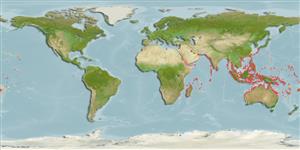分类 / Names
俗名 | 同种异名 | Catalog of Fishes(属, 种) | ITIS | CoL | WoRMS | Cloffa
Teleostei >
Carangiformes (Jacks)
鱸形目 (Jacks) >
Carangidae (Jacks and pompanos) > Trachinotinae
Etymology: Trachinotus: Greek, trachys, -eia, -ys = rough + Greek,noton = back (Ref. 45335).
Eponymy: Marcus Élieser Bloch (1723–1799) was a German physician and naturalist specialising in ichthyology. [...] (Ref. 128868), visit book page.
More on author: Lacepède.
Environment: milieu / climate zone / depth range / distribution range
生态学
海洋; 半咸淡水 礁区鱼类; 深度上下限 1 - 7 m (Ref. 5439). 热带; 31°N - 35°S, 30°E - 157°W
Indo-Pacific: Red Sea and East Africa (Ref. 3287) to the Marshall Islands and Samoa, north to southern Japan, south to Australia.
印度-太平洋: 红海与东非 (参考文献 3287) 到马绍尔群岛与美属萨摩亚, 北至日本南部, 南至澳洲。
Length at first maturity / 大小 / 重量 / 年龄
Maturity: Lm ?, range 58 - ? cm
Max length : 110 cm FL 雄鱼/尚未辨别雌雄; (Ref. 1602); common length : 40.0 cm TL 雄鱼/尚未辨别雌雄; (Ref. 3280); 最大体重: 3.4 kg (Ref. 40637)
背棘 (总数) : 7; 背的软条 (总数) : 18 - 20; 臀棘: 3; 臀鳍软条: 16 - 18.
颜色通常银色的, 腹面灰白的; 大的成鱼大部份金橘色的, 尤其腹。 背部的吻轮廓非常陡峭的; 软的背部与臀鳍叶非常升高。
Juveniles inhabit sandy shorelines and shallow sandy or muddy bays near river mouths while adults move out in schools to clear seaward coral and rock reefs (Ref. 5213). Juveniles are in small schools, while adults are usually solitary (Ref. 48635). Adults feed primarily on sand mollusks and other hard-shelled invertebrates (Ref. 9710).
稚鱼栖息于沙质海岸线与水浅的沙地或者在河口附近的泥泞的海湾虽然成鱼成群移出到清澈的临海礁石。 发现于靠近珊瑚与岩石礁了。 (参考文献 5213) 稚鱼形成小群鱼群, 虽然成鱼是通常独居性的。 (参考文献 48635) 主要吃沙地软件动物与其他的具有硬壳的无脊椎动物。 (参考文献 9710)
Life cycle and mating behavior
成熟度 | 繁殖 | 产卵场 | 卵 | 孕卵数 | 仔鱼
印度-太平洋: 红海与东非 (参考文献 3287) 到马绍尔群岛与美属萨摩亚, 北至日本南部, 南至澳洲。
Paxton, J.R., D.F. Hoese, G.R. Allen and J.E. Hanley, 1989. Pisces. Petromyzontidae to Carangidae. Zoological Catalogue of Australia, Vol. 7. Australian Government Publishing Service, Canberra, 665 p. (Ref. 7300)
世界自然保护联盟红皮书 (Ref. 130435: Version 2024-1)
人类利用
渔业: 低经济; 养殖: 商业性; 游钓鱼种: 是的; 水族馆: 公众的水族馆
工具
特别资料
下载 XML
网络资源
Estimates based on models
Preferred temperature (Ref.
123201): 24.8 - 29.3, mean 28.4 °C (based on 3759 cells).
Phylogenetic diversity index (Ref.
82804): PD
50 = 0.5000 [Uniqueness, from 0.5 = low to 2.0 = high].
Bayesian length-weight: a=0.02630 (0.01463 - 0.04729), b=2.83 (2.68 - 2.98), in cm total length, based on LWR estimates for this species & Genus-body shape (Ref.
93245).
营养阶层 (Ref.
69278): 3.8 ±0.36 se; based on food items.
回复力 (Ref.
120179): 中等的, 族群倍增时间最少 1.4 - 4.4年 (Assuming tm=2-4).
Fishing Vulnerability (Ref.
59153): High to very high vulnerability (73 of 100).
Climate Vulnerability (Ref.
125649): Very high vulnerability (93 of 100).
Nutrients (Ref.
124155): Calcium = 34.7 [14.6, 65.4] mg/100g; Iron = 0.575 [0.303, 1.202] mg/100g; Protein = 19.7 [17.7, 21.7] %; Omega3 = 0.0854 [, ] g/100g; Selenium = 27.9 [14.2, 59.5] μg/100g; VitaminA = 27.7 [6.5, 105.1] μg/100g; Zinc = 0.919 [0.590, 1.375] mg/100g (wet weight); based on
nutrient studies.
